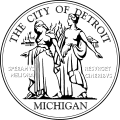Bankers Trust Company Building | |
 | |
| Location | 205 West Congress Street Detroit, Michigan |
|---|---|
| Coordinates | 42°19′44″N83°2′53″W / 42.32889°N 83.04806°W |
| Built | 1925 |
| Architect | Wirt C. Rowland of Smith, Hinchman & Grylls |
| Architectural style | Romanesque Revival |
| Part of | Detroit Financial District (ID09001067) |
| Designated CP | December 14, 2009 |
The Bankers Trust Company Building is an office building located at 205 West Congress Street in Downtown Detroit, Michigan, within the Financial District. Designed by Wirt C. Rowland of Smith, Hinchman & Grylls and completed in 1925 the ornately modeled building is an exquisite example of Italian Romanesque Revival architecture. [1]



